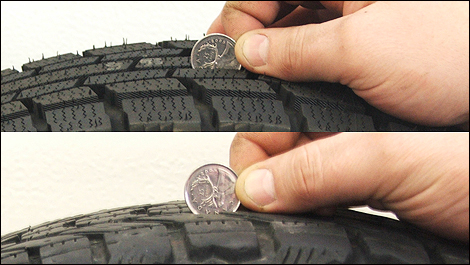Legally the answer is 2/32, but reasonably by the 4/32 the tire should be replaced.
Detailed information below is from Canadian Tire which explains winter tire tread depth the best:
6/32" -- Your tires have sufficient tread depth
5/32" -- Consider replacing your tires if wet road conditions are a concern
4/32" to 3/32" -- You should consider a tire replacement or monitor closely
2/32" (1.5mm) -- Your tires are considered legally bald and need to be replaced
Not all winter tires will wear out at the same speed, snow tires will generally last longer than models designed for icy conditions. Compound quality also plays a key role in tire durability. Most "ice tires" with the exception of Nokian's R2, the compound will only be good for the first 50% wear of the tire. After that point the special rubber compound looses it's grip, Michelin X-ice, Bridgestone Blizzack, Yokohama IG, and Toyo winter tires are just some examples. Not sure what secret compound Nokian uses in the R2 but it is throughout the entire tread life if the tire. If you are interested here is the article on those tires.
http://www.automotiveworld.com/news-releases/nokian-hakkapeliitta-r2-northern-comfort/
So how do you know how deep your tire tread depth is? There are several ways, here are the three most popular.
First, most newer tires produced incorporate a tire tread depth numeration system in the tire, an example below are my Nokian Hakkapeliitta5 tires. From the pictures you can see that the tread depth is 6/32 and moving towards 4/32 as they continue to wear the 6 will disappear.
Second, measuring your tires tread depth using a penny.
Canadian penny: Place a penny in the tire groove with the Queen’s crown facing down, if you can see the top of the Queen's crown you need to replace your tires.
The Canadian quarter (penny discontinued): Insert a 25¢ Canadian coin in one of the grooves with the caribou facing down. If you see the tip of its nose, it means the tread depth no longer meets 6/32 of an inch.

American penny coin: Turn the penny so that Lincoln’s head points down into the tread see if the top of his head disappears between the ribs. If it does, your tread is still above 2/32” . If you can see his entire head, it may be time to replace the tire because your tread is no longer deep enough.
Third, tire tread depth gauge, this is the most accurate way of measuring your tires tread depth.


Insert the pin of the gauge into the shallowest groove of the tread until the base of the gauge is flush with the tire, they read the scale.
Useful reading articles on tire tread depth:
http://tires.canadiantire.ca/en/info-centre/tireTreadDepth/
http://www.auto123.com/en/news/calculating-winter-tire-wear-and-preventing-premature-wear?artid=125534
http://www.continentaltire.ca/www/tires_ca_en/themes/contiacademy/tire_service_maintenance/tread_depth_en.html
http://www.bridgestonetire.com/tread-and-trend/drivers-ed/how-to-check-your-tire-tread-penny-test


No comments:
Post a Comment